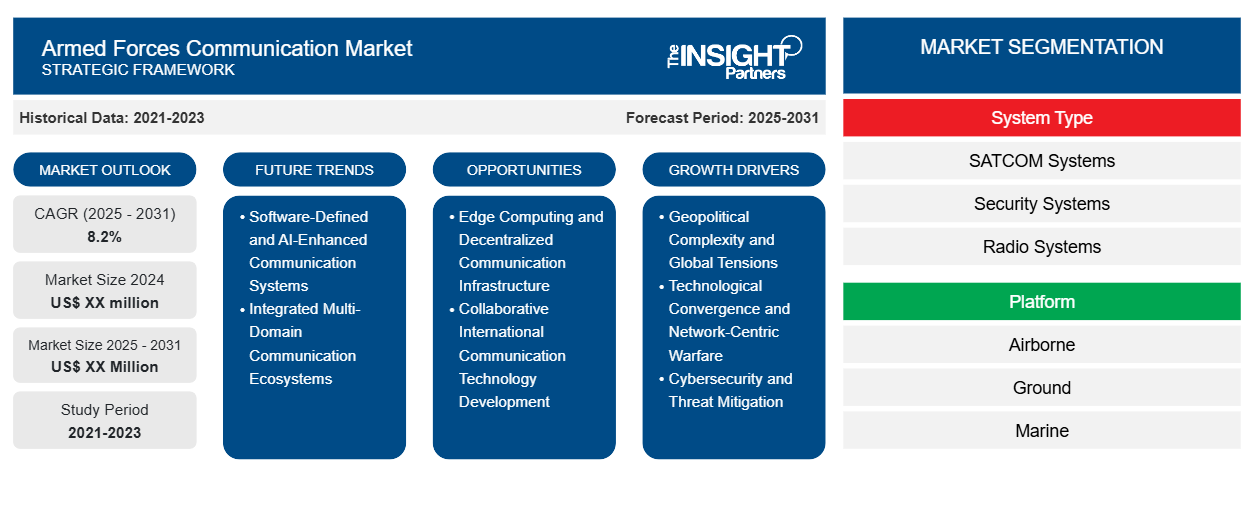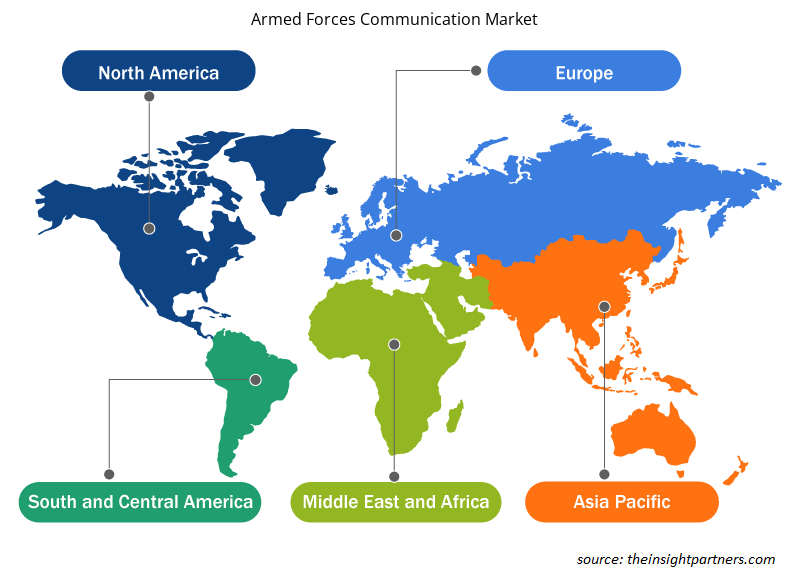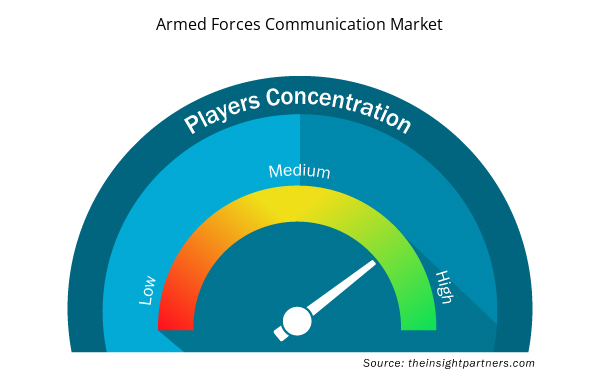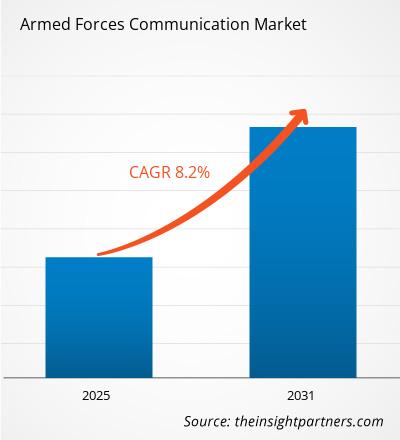The Armed Forces Communication Market is expected to register a CAGR of 8.2% from 2025 to 2031, with a market size expanding from US$ XX million in 2024 to US$ XX Million by 2031.
The report is segmented by System Type (SATCOM Systems, Security Systems, Radio Systems, Communication Management System); Platform [Airborne (Fixed Wing, Rotary Wing), Ground (Ground Stations, Combat Vehicles, Armored & SUpport Vehicles, Soldiers), Marine (Combat & Carrier Vessels, Patrol & Support Vessels, Submarines), Unmanned Systems (UAVs, UGVs, UUVs)]; Application (ISR, Combat Support, Command & Control, Others). The global analysis is further broken-down at regional level and major countries. The Report Offers the Value in USD for the above analysis and segments.
Purpose of the Report
The report Armed Forces Communication Market by The Insight Partners aims to describe the present landscape and future growth, top driving factors, challenges, and opportunities. This will provide insights to various business stakeholders, such as:
- Technology Providers/Manufacturers: To understand the evolving market dynamics and know the potential growth opportunities, enabling them to make informed strategic decisions.
- Investors: To conduct a comprehensive trend analysis regarding the market growth rate, market financial projections, and opportunities that exist across the value chain.
- Regulatory bodies: To regulate policies and police activities in the market with the aim of minimizing abuse, preserving investor trust and confidence, and upholding the integrity and stability of the market.
Armed Forces Communication Market Segmentation
System Type
- SATCOM Systems
- Security Systems
- Radio Systems
- Communication Management System
Platform
- Airborne
- Ground
- Marine
- Unmanned Systems
Application
- ISR
- Combat Support
- Command & Control
- Others
Geography
- North America
- Europe
- Asia-Pacific
- South and Central America
- Middle East and Africa
Customize This Report To Suit Your Requirement
You will get customization on any report - free of charge - including parts of this report, or country-level analysis, Excel Data pack, as well as avail great offers and discounts for start-ups & universities
Armed Forces Communication Market: Strategic Insights

- Get Top Key Market Trends of this report.This FREE sample will include data analysis, ranging from market trends to estimates and forecasts.
Armed Forces Communication Market Growth Drivers
- Geopolitical Complexity and Global Tensions: Increasing geopolitical uncertainties and regional conflicts drive significant investments in advanced communication technologies for military operations. Nations are prioritizing robust, secure, and resilient communication systems that can operate in contested environments, ensuring real-time information exchange, coordination, and strategic decision-making capabilities across distributed military units and command structures.
- Technological Convergence and Network-Centric Warfare: The rapid integration of artificial intelligence, quantum communications, and advanced encryption technologies is transforming military communication paradigms. Armed forces are investing heavily in sophisticated communication infrastructures that enable seamless interoperability, enhanced situational awareness, and rapid data transmission across diverse operational domains, including land, sea, air, and cyber environments.
- Cybersecurity and Threat Mitigation: Growing sophisticated cyber threats and potential communication infrastructure vulnerabilities are compelling armed forces to develop more resilient, adaptive, and secure communication networks. Investments in cutting-edge cybersecurity technologies, including quantum-resistant encryption, advanced threat detection systems, and redundant communication protocols, are becoming critical for maintaining operational integrity.
Armed Forces Communication Market Future Trends
- Software-Defined and AI-Enhanced Communication Systems: The migration towards software-defined radio (SDR) and artificial intelligence-driven communication platforms is revolutionizing military communication strategies. These adaptive systems enable rapid reconfiguration, dynamic spectrum utilization, and intelligent signal processing, allowing military units to maintain communication effectiveness in complex and rapidly changing operational environments.
- Integrated Multi-Domain Communication Ecosystems: Armed forces are progressively developing comprehensive communication ecosystems that seamlessly integrate multiple operational domains. These interconnected networks leverage satellite, terrestrial, and emerging communication technologies to provide unified, real-time information sharing, enhancing coordination, strategic planning, and operational responsiveness across different military branches.
Armed Forces Communication Market Opportunities
- Edge Computing and Decentralized Communication Infrastructure: The emergence of edge computing technologies presents significant opportunities for developing decentralized, resilient communication networks. By distributing computational and communication capabilities closer to operational units, armed forces can reduce latency, enhance network survivability, and create more flexible and adaptive communication architectures.
- Collaborative International Communication Technology Development: Growing international security challenges are creating opportunities for collaborative technology development and strategic partnerships. Multinational defense initiatives, joint research programs, and technology sharing agreements can accelerate innovation in communication technologies, standardize interoperability protocols, and create more cost-effective solutions for armed forces worldwide.
Armed Forces Communication Market Regional Insights
The regional trends and factors influencing the Armed Forces Communication Market throughout the forecast period have been thoroughly explained by the analysts at Insight Partners. This section also discusses Armed Forces Communication Market segments and geography across North America, Europe, Asia Pacific, Middle East and Africa, and South and Central America.

- Get the Regional Specific Data for Armed Forces Communication Market
Armed Forces Communication Market Report Scope
| Report Attribute | Details |
|---|---|
| Market size in 2024 | US$ XX million |
| Market Size by 2031 | US$ XX Million |
| Global CAGR (2025 - 2031) | 8.2% |
| Historical Data | 2021-2023 |
| Forecast period | 2025-2031 |
| Segments Covered |
By System Type
|
| Regions and Countries Covered | North America
|
| Market leaders and key company profiles |
Armed Forces Communication Market Players Density: Understanding Its Impact on Business Dynamics
The Armed Forces Communication Market market is growing rapidly, driven by increasing end-user demand due to factors such as evolving consumer preferences, technological advancements, and greater awareness of the product's benefits. As demand rises, businesses are expanding their offerings, innovating to meet consumer needs, and capitalizing on emerging trends, which further fuels market growth.
Market players density refers to the distribution of firms or companies operating within a particular market or industry. It indicates how many competitors (market players) are present in a given market space relative to its size or total market value.
Major Companies operating in the Armed Forces Communication Market are:
- Thales Group
- Aselsan A.?.
- BAE Systems
- Cobham PLC
- HARRIS Corporation
Disclaimer: The companies listed above are not ranked in any particular order.

- Get the Armed Forces Communication Market top key players overview
Key Selling Points
- Comprehensive Coverage: The report comprehensively covers the analysis of products, services, types, and end users of the Armed Forces Communication Market, providing a holistic landscape.
- Expert Analysis: The report is compiled based on the in-depth understanding of industry experts and analysts.
- Up-to-date Information: The report assures business relevance due to its coverage of recent information and data trends.
- Customization Options: This report can be customized to cater to specific client requirements and suit the business strategies aptly.
The research report on the Armed Forces Communication Market can, therefore, help spearhead the trail of decoding and understanding the industry scenario and growth prospects. Although there can be a few valid concerns, the overall benefits of this report tend to outweigh the disadvantages.
- Historical Analysis (2 Years), Base Year, Forecast (7 Years) with CAGR
- PEST and SWOT Analysis
- Market Size Value / Volume - Global, Regional, Country
- Industry and Competitive Landscape
- Excel Dataset


- Online Exam Proctoring Market
- Lyophilization Services for Biopharmaceuticals Market
- Smart Locks Market
- Mail Order Pharmacy Market
- Dealer Management System Market
- Formwork System Market
- Intradermal Injection Market
- Water Pipeline Leak Detection System Market
- Integrated Platform Management System Market
- Semiconductor Metrology and Inspection Market

Report Coverage
Revenue forecast, Company Analysis, Industry landscape, Growth factors, and Trends

Segment Covered
This text is related
to segments covered.

Regional Scope
North America, Europe, Asia Pacific, Middle East & Africa, South & Central America

Country Scope
This text is related
to country scope.
Frequently Asked Questions
Some of the customization options available based on request are additional 3-5 company profiles and country-specific analysis of 3-5 countries of your choice. Customizations are to be requested/discussed before making final order confirmation, as our team would review the same and check the feasibility.
The report can be delivered in PDF/PPT format; we can also share excel dataset based on the request.
The major factors driving the armed forces communication market are:
1. Growing Demand for Electronic Communications
2. Demand for Security in Communication Systems
Some of the major trends driving the armed forces communication market are:
1. Demand for Satellite-Based Military Communications
2. Technological Advancements in Radio Communications
The Armed Forces Communication Market is estimated to witness a CAGR of 8.2% from 2023 to 2031
Trends and growth analysis reports related to Aerospace and Defense : READ MORE..
1. Thales Group
2. Aselsan A.?.
3. BAE Systems
4. Cobham PLC
5. HARRIS Corporation
6. Inmarsat PLC
7. Iridium Communications Inc.
8. L3 technologies, Inc.
9. Lockheed Martin Corporation
10. Saab AB

 Get Free Sample For
Get Free Sample For